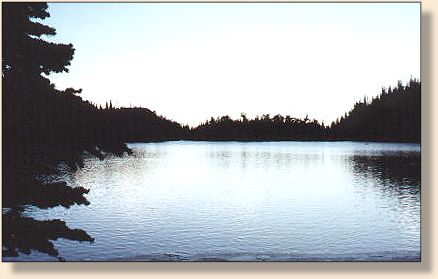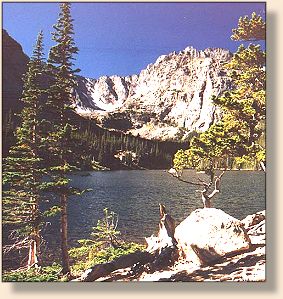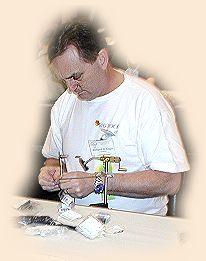In August we went to Rocky Mountain National Park on
our vacation. We have been there before and I had fished
in the streams around the campgrounds and the Alluvial fan
several times. I had caught rainbow and brown trout there
but had never caught a Greenback Cutthroat.

This year we decided we were going to take some different
hikes. One of these was up to the lake called the Loch. This
lake is at about 9,000 feet so it takes this flat-land foreigner
a little while to get there.
It is a pleasant hike and we spent a good amount of time looking
at the scenery. This also gave us a chance to catch our breath.
The lake is in a beautiful setting in a bowl on the mountain side.
I looked the area over and decided to go out on the logs that
were stacked up near the outlet of the lake. This area seemed
to have the most room for a back cast. I strung everything up
and tied on a parachute Adams. I cast out into the lake and was
not ready for a trout to hit the fly. So I missed it and got a
bad case of buck fever. I missed the next five fish because I
yanked the hook out of their mouth. I was on a hair trigger to
set the hook even though I knew better.

I forced myself to sit for a couple to minutes to gain my
composure. When I felt I had it, I went back to fishing. On
my first cast I hooked a small cutthroat. I was using a 3 wt.
rod so it was a lot of fun to catch it. All of the cutthroats
have to be released.
A few other fly fishers showed up that had been around the
lake looking for a place to fish and told me that I had the
best spot. I invited them to come out and we would take turns
casting. We had about 50 feet to work in and with one person
at a time casting it seemed to work well.
I was curious to see if any other flies would work so I tied
on a black Humpy made with a black foam back. I cast this out
and let it sit on the water for a few seconds. I twitched
it a little bit without really moving the fly. I had a big
swirl under the fly and it disappeared. I set the hook and
had a real tussle on my hands. When I got the fish in, we
measured it at 17 inches long. A Park Ranger there told me
that it was a very large fish for the lake.
The advantage of the foam backed Humpy is that you can cast
it again right away because they float so well. I cast about
five feet to the side of where I had cast before. The fly
barely hit the water when another fish hit it. This was a
15-inch fish. Both of the guys fishing beside me wanted to
use the fly. I told them "No Way." I then took out a couple
more Humpies and gave one to each of them. I always have
several of any patterns that I am using along with me. I
rarely carry less that 10 of a pattern which means I may
have more boxes but have not run out of a pattern in a
long time.
 We all caught several trout using these flies. My family
did decide after a couple of hours that they wanted to
leave. I felt this was fair as they had given me that much
time. Both of the other fly fishers wanted to give me back
the fly but I told them to keep them.
We all caught several trout using these flies. My family
did decide after a couple of hours that they wanted to
leave. I felt this was fair as they had given me that much
time. Both of the other fly fishers wanted to give me back
the fly but I told them to keep them.
As we headed down the trail I was asked by other folks
carrying fly rods if I had been successful. My kids had
great fun telling them that I had caught some of the
largest trout the Park Ranger had seen come out of the
lake. They all wanted to know what pattern I had used.
I showed them and they all said they had nothing like that.
I ended up giving away all 12 of the black Humpies I had
with me. Funny thing is that over the next two days I got
eleven of them back. Several of the folks had asked where
we were camped and when they had finished fishing brought
the fly back me. This was unexpected but nice.
It was a fun experience to be able to fish in that beautiful
spot. Never be afraid to try a different pattern when you
are someplace. It was not a pattern listed in any of the shops
in the area to use in the Park. I just thought a black bug
would work well and had to try.
Hope you can get out on the water. ~ Rick
Credits: Photos courtesy of the U.S. National Park Service.
|




 We all caught several trout using these flies. My family
did decide after a couple of hours that they wanted to
leave. I felt this was fair as they had given me that much
time. Both of the other fly fishers wanted to give me back
the fly but I told them to keep them.
We all caught several trout using these flies. My family
did decide after a couple of hours that they wanted to
leave. I felt this was fair as they had given me that much
time. Both of the other fly fishers wanted to give me back
the fly but I told them to keep them.